Sri Aurobindo was born in 1872 in Calcutta, India. At the tender age of seven, he was sent to England by his father for higher studies and that is where he remained till the age of twenty-one. While in England, he once came across a brief statement on the “Six philosophies of India”and was especially struck by the concept of the Atman in Advaita. He thought it might bear a clue to the reality behind the phenomenal world but he couldn’t ascertain its deeper significance at the time.
He returned back from England to India in February of 1893 on board a steamship as was the custom in those days. When the ship docked at Apollo Bunder (seen below) in Bombay(now Mumbai), he felt a vast calm descending upon him. This envelope of calm that ensconced him persisted for many months.
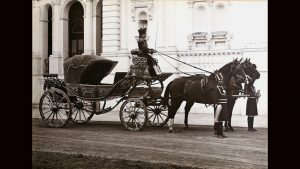
The Royal Gold Buggy, Baroda
He also experienced the formless aspect of God, essentially as consciousness. In Baroda, the
carriage in which Sri Aurobindo was travelling was about to meet with an accident. At that very instance
a higher force intervened and the accident was averted. He realized that it was not a coincidence but
the working of some force that saved him. “The Godhead” written on 13/09/1939 expresses this
experience. It explains how the incident took place and how he saw “the vision of the Godhead surging from within” (CWSA 36: 110) saved him.
The Godhead
I sat behind the dance of Danger’s hooves
In the shouting street that seemed a futurist’s whim,
And suddenly felt, exceeding Nature’s grooves,
In me, enveloping me the body of Him.
Above my head a mighty head was seen,
A face with the calm of immortality
And an omnipotent gaze that held the scene
In the vast circle of its sovereignty.
His hair was mingled with the sun and breeze;
The world was in His heart and He was I:
I housed in me the Everlasting’s peace,
The strength of One whose substance cannot die.
The moment passed and all was as before;
Only that deathless memory I bore.
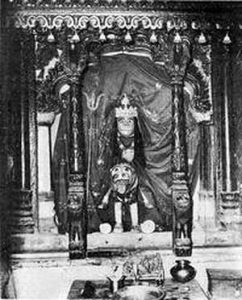
Idol of Mahakali — Chandod Karanali
In 1905, during his travels around the region of Baroda, he visited a temple dedicated to the Goddess Kali in Chandod on the banks of the Narmada river, where he experienced a palpable living presence of Kali manifesting before him.This experience was noted down in his poem “The Stone Goddess” seen below.
The Stone Goddess
In a town of gods, housed in a little shrine,
From sculptured limbs the Godhead looked at me, —
A living Presence deathless and divine,
A Form that harboured all infinity.
The great World-Mother and her mighty will
Inhabited the earth’s abysmal sleep,
Voiceless, omnipotent, inscrutable,
Mute in the desert and the sky and deep.
Now veiled with mind she dwells and speaks no word,
Voiceless, inscrutable, omniscient,
Hiding until our soul has seen, has heard
The secret of her strange embodiment,
One in the worshipper and the immobile shape,
A beauty and mystery flesh or stone can drape.
In two of his letters he relates the experience of seeing Goddess Kali as “the living presence of Kali in a
shrine on the banks of the Narmada” (CWSA 36: 110). He describes elsewhere – “Or you stand before a
temple of Kali beside a sacred river and see what? – a sculpture, a gracious piece of architecture, but in
a moment mysteriously, unexpectedly there is instead a Presence, a Power, a Face that looks into yours,
an inner sight in you has regarded the World-Mother” (Letters on Yoga I: 199)
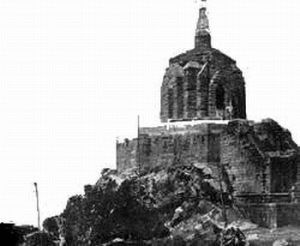
Takht-e-Suleman, Shankaracharya’s Temple, Kashmir
On his official tour to Kashmir Sri Aurobindo had “the realisation of the vacant Infinite whilewalking on the ridge of the Takht-i-[Suleman]” (CWSA 36: 110). This was the experience of the nirguna Brahman same as Shankaracharya experienced. The sonnet “Adwaita” written on 19/10/1939 is an expression of this experience.
Advaita
I walked on the high-wayed Seat of Solomon
Where Shankaracharya’s tiny temple stands
Facing Infinity from Time’s edge, alone
On the bare ridge ending earth’s vain romance.
Around me was a formless solitude:
All had become one strange Unnameable,
An unborn sole Reality world-nude,
Topless and fathomless, for ever still.
A Silence that was Being’s only word,
The unknown beginning and the voiceless end
Abolishing all things moment-seen or heard,
On an incommunicable summit reigned,
A lonely Calm and void unchanging Peace
On the dumb crest of Nature’s mysteries.
The hilltop temple
After unnumbered steps of a hill-stair
I saw upon earth’s head brilliant with sun
The immobile Goddess in her house of stone
In a loneliness of meditating air.
Wise were the human hands that set her there
Above the world and Time’s dominion;
The Soul of all that lives, calm, pure, alone,
Revealed its boundless self mystic and bare.
Our body is an epitome of some Vast
That masks its presence by our humanness.
In us the secret Spirit can indite
A page and summary of the Infinite,
A nodus of Eternity expressed
Live in an image and a sculptured face.
What should we make of such enigmatic incidents? The Mother Mirra Alfassa had the following to say on the mystic relevance of such early experiences.
For those who have come upon earth fully conscious of their entire being and conscious of their Origin, there is at first a period when this consciousness gets veiled by the physical life and the body-consciousness. It withdraws deep within and waits for the hour when the outer circumstances will make it necessary for that inner self to manifest and to become fully active in the body. And generally, as life is organised, it is some more or less dramatic event that makes this change not only possible but needed.
Even those who have come fully conscious, because they are compelled to take birth in the body of a child, their consciousness withdraws for many years, more or less, and has not the full activity that it had in other worlds. But some circumstance, some event tears off the veil and the inner consciousness takes back its place and its activity. It is that that is fully described in these lines of Savitri.
It is only when the outer crust of the ordinary life is violently broken by some unexpected and tragic event that the inner consciousness has the opportunity of taking the place of this outward movement and governing fully the whole being. From the point of view of growth of consciousness, that is the justification of all these dramatic events. An eventless life is not often a progressive life.[3]
Even his godlike strength to rise must fall:
His greater consciousness withdrew behind;
Dim and eclipsed, his human outside strove
To feel again the old sublimities,
Bring the high saving touch, the ethereal flame,
Call back to its dire need the divine Force.(Sri Aurobindo. Savitri, Book I, Canto III
Yogi Lele – A Brief Role
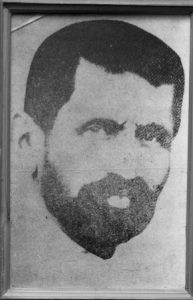
Yogi Vishnu Bhaskar Lele – Sri Aurobindo’s human Guru for a brief duration
…… “It was my great debt to Lele that he showed me this. ‘Sit in meditation,’ he said, ‘but do not think, look only at your mind; you will see thoughts coming into it: before they can enter throw these away from your mind till your mind is capable of entire silence.’ I had never heard before of thoughts coming visibly into the mind from outside, but I did not think either of questioning the truth or the possibility, I simply sat down and did it. In a moment my mind became silent as a windless air on a high mountain summit and then I saw one thought and then another coming in a concrete way from outside; I flung them away before they could enter and take hold of the brain and in three days I was free. From that moment, in principle, the mental being in me became a free Intelligence, a universal Mind, not limited to the narrow circle of personal thought as a labourer in a thought factory, but a receiver of knowledge from all the hundred realms of being and free to choose what it willed in this vast sight-empire and thought-empire.” ….
From ‘Sri Aurobindo to Dilip’ (Vol I) , Page 236
Human Guru not necessary Feb. 1908
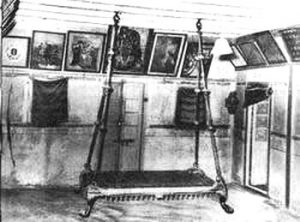
The room in Majumdar’s house where Sri Aurobindo sat for meditation
Lele had come to Calcutta at Barin’s invitation towards the end of February, 1908. “He asked me if I meditated in the morning and in the evening. I said, ‘No’.” Without waiting for any explanation, Yogi Lele began to give instructions to Sri Aurobindo. “I did not insult him but I did not act upon his advice. I had received the command from within that a human Guru was not necessary for me. As to ‘dhyana’ I was not prepared to tell him that I was practically meditating the whole day.” From then onwards ‘we began to follow our own ways’.
Extract from: Sujata Nahar ‘ Mother’s Chronicles (Book 5)’ ,Page 448
Nirvana
All is abolished but the mute Alone.
The mind from thought released, the heart from grief
Grow inexistent now beyond belief;
There is no I, no Nature, known-unknown.
The city, a shadow picture without tone,
Floats, quivers unreal; forms without relief
Flow, a cinema’s vacant shapes; like a reef
Foundering in shoreless gulfs the world is done.
Only the illimitable Permanent
Is here. A Peace stupendous, featureless, still,
Replaces all, what once was I, in It
A Silent unnamed emptiness content
Either to fade in the Unknowable
Or thrill with the luminous seas of the Infinite.
“As for calm and silence, there is no need of the supramental to get that. One can get it even on the level of Higher Mind which is the next above the human intelligence. I got these things in 1908, 27 years ago, and I can assure you they were solid enough and marvellous enough in all conscience without any need of supramentality to make it more so. Again, ‘a calm that looks like action and motion’ is a phenomenon of which I know nothing. A calm or silence that is what I have had the proof is that out of an absolute silence of the mind I edited the Bande Mataram for 4 months and wrote 6 volumes of the Arya, not to speak of all the letters and messages etc. I have written since.” – Sri Aurobindo